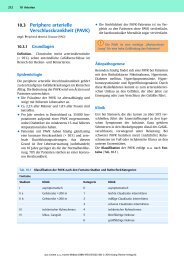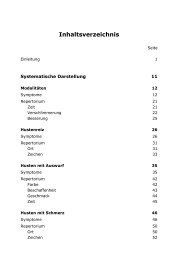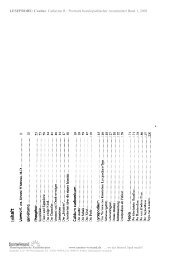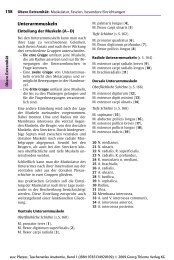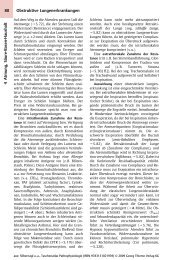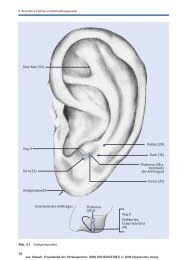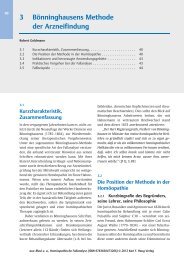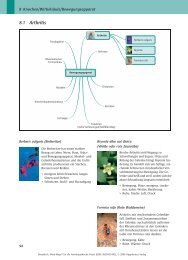alphabetical index of plant families and groups - Sunrise Versand
alphabetical index of plant families and groups - Sunrise Versand
alphabetical index of plant families and groups - Sunrise Versand
You also want an ePaper? Increase the reach of your titles
YUMPU automatically turns print PDFs into web optimized ePapers that Google loves.
� Leaves born in whorls, 3–4, palmately compound; leaflets 5 [quinquefolius =<br />
with 5 leaves], long-stalked, obovate, sharply serrate, acuminate, smooth on<br />
both sides, with scattered bristles on the veins above.<br />
� Flowers small, yellowish-green, in single terminal umbel.<br />
� Fruit a bright-scarlet drupe, ca. 1.2 cm in diameter, with 2–3 semicircular, white<br />
seeds.<br />
� Outermost florets ripen first <strong>and</strong> their fruits <strong>of</strong>ten obtain their full size before<br />
the central ones are exp<strong>and</strong>ed; the central florets are frequently abortive.<br />
Chinese or Asian ginseng<br />
� Herbaceous perennial, 30–60 cm high, thick, fusiform roots <strong>and</strong> simple stems.<br />
� Native range: Korea <strong>and</strong> northern China.<br />
� Habitat: Deciduous broad-leaved forests; extremely rare in the wild; mostly<br />
cultivated.<br />
� Leaves borne in whorls, 3–6, palmately compound; leaflets 3–5, long-stalked,<br />
obovate, 7–20 cm long, serrate.<br />
� Flowers small, yellowish-green, in single terminal umbel.<br />
� Fruit a bright red drupe, globose, about 1.5 cm in diameter, with 2 flat, yellow<br />
seeds.<br />
� Outermost florets ripen first <strong>and</strong> their fruits <strong>of</strong>ten obtain their full size before<br />
the central ones are exp<strong>and</strong>ed; the central florets are frequently abortive.<br />
Medicinal Uses<br />
‘Ginseng is perhaps the most widely recognised <strong>plant</strong> used in traditional<br />
medicine <strong>and</strong> now plays a major role in the herbal health care market. For more<br />
than 2,000 years, various forms have been used in medicine. The name Panax<br />
derives from the Greek word for “all healing” <strong>and</strong> its properties have been no<br />
less touted. Ginseng root’s man-shaped figure [shen-seng means “man-root”] led<br />
proponents <strong>of</strong> the Doctrine <strong>of</strong> Signatures, an ancient philosophy, to believe that<br />
the root could strengthen any part <strong>of</strong> the body. Through the ages, the root has<br />
been used in the treatment <strong>of</strong> asthenia [loss <strong>of</strong> strength], atherosclerosis, blood<br />
<strong>and</strong> bleeding disorders, colitis <strong>and</strong> to relieve the symptoms <strong>of</strong> ageing, cancer <strong>and</strong><br />
senility.<br />
‘Ginseng is popularly used for its adaptogenic, anti-neoplastic, immunomodulatory,<br />
cardiovascular, CNS, endocrine <strong>and</strong> ergogenic effects, but these uses<br />
have not been confirmed by clinical trials. . . . Note that the pr<strong>of</strong>ile <strong>of</strong> particular<br />
ginsenosides differs between American <strong>and</strong> Asian ginseng; however, total<br />
ginsenoside content is similar.’ [www.drugs.com]<br />
© Saltire Books Ltd<br />
Adverse Reactions<br />
‘The most common adverse reactions with ginseng are nervousness <strong>and</strong> excitation.<br />
However, there have been reports <strong>of</strong> diffuse mammary nodularity <strong>and</strong><br />
vaginal bleeding. A hypoglycaemic effect has also been documented. Postmarketing<br />
surveillance <strong>of</strong> CVT-E002 [COLD-fX, a patented, proprietary extract<br />
containing mainly oligosaccharides <strong>and</strong> polysaccharides from North American<br />
ginseng] in Canada from 1996 to 2006 led to 100 documented adverse reaction<br />
500 Family ARALIACEAE



